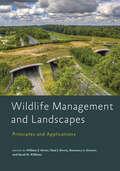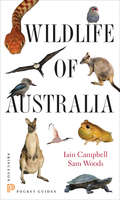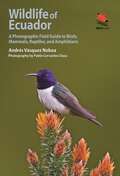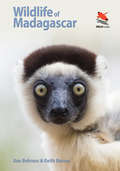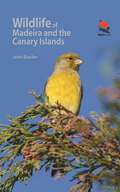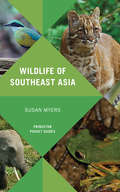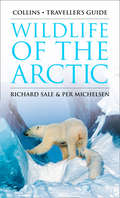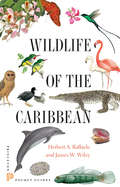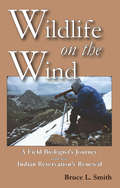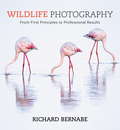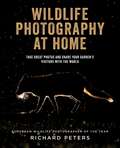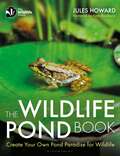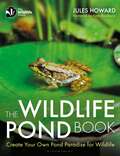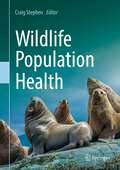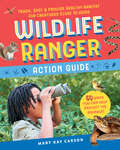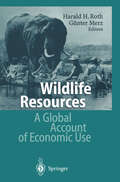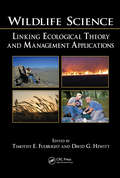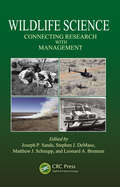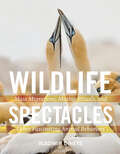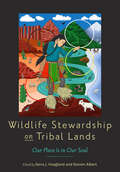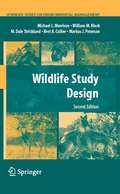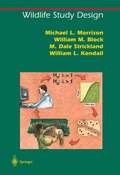- Table View
- List View
Wildlife Management and Landscapes: Principles and Applications (Wildlife Management and Conservation)
by William F. Porter, Chad J. Parent, Rosemary A. Stewart and David M. WilliamsWildlife management specialists and landscape ecologists offer a new perspective on the important intersection of these fields in the twenty-first century.It's been clear for decades that landscape-level patterns and processes, along with the tenets and tools of landscape ecology, are vitally important in understanding wildlife-habitat relationships and sustaining wildlife populations. Today, significant shifts in the spatial scale of extractive, agricultural, ranching, and urban land uses are upon us, making it more important than ever before to connect wildlife management and landscape ecology. Landscape ecologists must understand the constraints that wildlife managers face and be able to use that knowledge to translate their work into more practical applications. Wildlife managers, for their part, can benefit greatly from becoming comfortable with the vocabulary, conceptual processes, and perspectives of landscape ecologists.In Wildlife and Landscapes, the foremost landscape ecology experts and wildlife management specialists come together to discuss the emerging role of landscape concepts in habitat management. Their contributions• make the case that a landscape perspective is necessary to address management questions• translate concepts in landscape ecology to wildlife management• explain why studying some important habitat-wildlife relationships is still inherently difficult• explore the dynamic and heterogeneous structure of natural systems• reveal why factors such as soil, hydrology, fire, grazing, and timber harvest lead to uncertainty in management decisions• explain matching scale between population processes and management• discuss limitations to management across jurisdictional boundaries and balancing objectives of private landowners and management agencies• offer practical ideas for improving communication between professionals• outline the impediments that limit a full union of landscape ecology and wildlife managementUsing concrete examples of modern conservation challenges that range from oil and gas development to agriculture and urbanization, the volume posits that shifts in conservation funding from a hunter constituent base to other sources will bring a dramatic change in the way we manage wildlife. Explicating the foundational similarity of wildlife management and landscape ecology, Wildlife and Landscapes builds crucial bridges between theoretical and practical applications.Contributors: Jocelyn L. Aycrigg, Guillaume Bastille-Rousseau, Jon P. Beckmann, Joseph R. Bennett, William M. Block, Todd R. Bogenschutz, Teresa C. Cohn, John W. Connelly, Courtney J. Conway, Bridgett E. Costanzo, David D. Diamond, Karl A. Didier, Lee F. Elliott, Michael E. Estey, Lenore Fahrig, Cameron J. Fiss, Jacqueline L. Frair, Elsa M. Haubold, Fidel Hernández, Jodi A. Hilty, Joseph D. Holbrook, Cynthia A. Jacobson, Kevin M. Johnson, Jeffrey K. Keller, Jeffery L. Larkin, Kimberly A. Lisgo, Casey A. Lott, Amanda E. Martin, James A. Martin, Darin J. McNeil, Michael L. Morrison, Betsy E. Neely, Neal D. Niemuth, Chad J. Parent, Humberto L. Perotto-Baldivieso, Ronald D. Pritchert, Fiona K. A. Schmiegelow, Amanda L. Sesser, Gregory J. Soulliere, Leona K. Svancara, Stephen C. Torbit, Joseph A. Veech, Kerri T. Vierling, Greg Wathen, David M. Williams, Mark J. Witecha, John M. Yeiser
Wildlife of Australia
by Iain Campbell Sam WoodsIdeal for the nature-loving traveler, Wildlife of Australia is a handy photographic pocket guide to the most widely seen birds, mammals, reptiles, amphibians, and habitats of Australia. The guide features more than 400 stunning color photographs, and coverage includes 350 birds, 70 mammals, 30 reptiles, and 16 frogs likely to be encountered in Australia's major tourist destinations. Accessible species accounts are useful for both general travelers and serious naturalists, and the invaluable habitat section describes the Australian bush and its specific wildlife. Animal species with similar features are placed on the same plates in order to aid identification. Wildlife of Australia is an indispensable and thorough resource for any nature enthusiast interested in this remarkable continent. Easy-to-use pocket guide More than 400 high-quality photographs Accessible text aids identification Habitat guide describes the Australian bush and its specific wildlife Coverage includes the 350 birds, 70 mammals, 30 reptiles, and 16 frogs most likely to be seen on a trip around Australia
Wildlife of Ecuador: A Photographic Field Guide to Birds, Mammals, Reptiles, and Amphibians
by Andrés Vásquez Noboa Pablo Cervantes DazaMainland Ecuador's spectacular wildlife makes it a magnet for nature tourists, but until now there hasn't been a go-to, all-in-one guide geared to the general reader. With this handy and accessible guide, visitors now have everything they need to identify and enjoy the majority of birds and animals they are likely to see. Written and illustrated by two of Ecuador's most experienced nature guides and photographers, this book covers more than 350 birds, mammals, amphibians, and reptiles. It features over 400 stunning color photographs and includes a range map for each species, as well as a brief account of the country's natural history and biogeography. With its extensive coverage, attractive and easy-to-use layout, beautiful photographs, and nontechnical text, this is an essential guide for anyone who wants to explore the natural wonders of Ecuador.An essential all-in-one guide to mainland Ecuador's amazing wildlifeUnique and attractive layout with more than 400 stunning color photographsCovers more than 350 of the most frequently seen birds, mammals, reptiles, and amphibiansUses a habitat-based approach to aid identificationAccessible text provides key information on identification, behavior, biology, and conservationPhotos, maps, and text are presented together for ease of use
Wildlife of Madagascar
by Ken Behrens Keith BarnesThe Indian Ocean island of Madagascar is one of the world's great natural treasures and ecotourism destinations. Despite being an island, it is home to nearly an entire continent’s variety of species, from the famous lemurs to a profusion of bizarre and beautiful birds, reptiles and amphibians. Wildlife of Madagascar is a compact and beautifully illustrated photographic guide, and an essential companion for any visitor or resident. With an eye-catching design, authoritative and accessible text and easy-to-use format, it provides information on identification, distribution, habitat, behaviour, biology and conservation for all the mammals, birds, reptiles, amphibians and butterflies likely to be seen. The most comprehensive single-volume field guide to Madagascar’s wildlife Attractive layout features more than 900 stunning colour photographs Covers the mammals, birds, reptiles, amphibians and butterflies, and some of the other invertebrates and plants, most likely to be seen Provides key information about identification, distribution, habitat, behaviour and conservation Introductory sections provide background information on Madagascar and its unique environments
Wildlife of Madeira and the Canary Islands: A Photographic Field Guide to Birds, Mammals, Reptiles, Amphibians, Butterflies and Dragonflies (Wildlife Explorer Guides)
by John BowlerThis beautifully illustrated photographic field guide is the first to focus on the identification of the fascinating, diverse and unique wildlife of Madeira and the Canary Islands--featuring the birds, mammals, reptiles, amphibians, butterflies and dragonflies that are most likely to be seen. Richly illustrated introductory sections cover the key wildlife sites to visit on each of the islands and provide an overview of the islands' geography, climate, habitat types and current conservation efforts. Stunning colour photographs highlight the key identification features of each species, and the accompanying text covers status, habitat preference, behaviour and, where appropriate, calls. The guide also features an up-to-date distribution map for each species. Complete with an attractive, user-friendly design, this is a must-have guide for all visitors to these magical islands.A beautifully designed and illustrated photographic field guide to the wildlife of Madeira and the Canary IslandsHighlights the islands' unique native species and their conservation statusCovers all birds, land and marine mammals, reptiles, amphibians, butterflies and dragonflies that are likely to be seenFeatures richly illustrated introductory sections on key sites to visit on each of the islands, covering their geography, climate, habitats and conservationIncludes distribution maps for all species, as well as information on occurrence, status, habitat preference, behaviour and calls
Wildlife of Southeast Asia
by Susan MyersThis handy photographic guide offers a stunning look at the wildlife of Southeast Asia, which includes Burma, Thailand, Laos, Cambodia, Vietnam, West Malaysia, and Singapore. Accessible text and more than 500 color photographs help readers to learn about and identify the most common species found in the region, particularly the mammals, birds, reptiles, amphibians, and insects that visitors will most likely encounter. Detailed photos are accompanied on facing pages by succinct species accounts highlighting key identification features, status, and distribution. The book's brief introduction offers readers useful information on major wildlife sites as well as practical advice on making the most of a wildlife-watching trip.Wildlife of Southeast Asia is the essential resource for visitors and residents interested in the fauna of this fascinating area of the world.A photographic guide to the wildlife of Southeast Asia, including Burma, Thailand, Laos, Cambodia, Vietnam, West Malaysia, and SingaporeMore than 500 stunning color photographsAccessible species accounts highlight key identification features, status, and distributionA brief introduction discusses wildlife locations and practical travel know-how
Wildlife of Southeast Asia
by Susan MyersThis handy photographic guide offers a stunning look at the wildlife of Southeast Asia, which includes Burma, Thailand, Laos, Cambodia, Vietnam, West Malaysia, and Singapore. Accessible text and more than 500 color photographs help readers to learn about and identify the most common species found in the region, particularly the mammals, birds, reptiles, amphibians, and insects that visitors will most likely encounter. Detailed photos are accompanied on facing pages by succinct species accounts highlighting key identification features, status, and distribution. The book's brief introduction offers readers useful information on major wildlife sites as well as practical advice on making the most of a wildlife-watching trip.Wildlife of Southeast Asia is the essential resource for visitors and residents interested in the fauna of this fascinating area of the world.A photographic guide to the wildlife of Southeast Asia, including Burma, Thailand, Laos, Cambodia, Vietnam, West Malaysia, and SingaporeMore than 500 stunning color photographsAccessible species accounts highlight key identification features, status, and distributionA brief introduction discusses wildlife locations and practical travel know-how
Wildlife of the Arctic (Traveller’s Guide)
by Richard SaleThis book celebrates the Arctic, exploring the natural history that has so inspired generations.
Wildlife of the Caribbean
by Birds of the Wes Herbert A. Raffaele James WileyThe essential guide to the living wonders of the Caribbean islandsThis is the first comprehensive illustrated guide to the natural world of the Caribbean islands. It contains 600 vivid color images featuring 451 species of plants, birds, mammals, fish, seashells, and much more. While the guide primarily looks at the most conspicuous and widespread species among the islands, it also includes rarely seen creatures—such as the Rhinoceros Iguana and Cuban Solenodon—giving readers a special sense of the region's diverse wildlife.Each species is represented by one or more color photos or illustrations; details regarding its identification, status, and distribution; and interesting aspects of its life history or relationship to humans. In addition, an introductory section focuses on the unique characteristics of the Caribbean’s fauna and flora, the threats faced by both, and some of the steps being taken to sustain the area’s extraordinary natural heritage.Wildlife of the Caribbean is the essential field guide for learning about the living wonders in this area of the world.The only guide of its kind for the Caribbean islands600 detailed color images feature 451 amazing speciesStraightforward descriptions suitable for general audienceCompact size makes the guide easy to carry
Wildlife of the Caribbean
by Herbert A. Raffaele James WileyThis is the first comprehensive illustrated guide to the natural world of the Caribbean islands. It contains 600 vivid color images featuring 451 species of plants, birds, mammals, fish, seashells, and much more. While the guide primarily looks at the most conspicuous and widespread species among the islands, it also includes rarely seen creatures—such as the Rhinoceros Iguana and Cuban Solenodon—giving readers a special sense of the region's diverse wildlife.Each species is represented by one or more color photos or illustrations; details regarding its identification, status, and distribution; and interesting aspects of its life history or relationship to humans. In addition, an introductory section focuses on the unique characteristics of the Caribbean’s fauna and flora, the threats faced by both, and some of the steps being taken to sustain the area’s extraordinary natural heritage.Wildlife of the Caribbean is the essential field guide for learning about the living wonders in this area of the world.The only guide of its kind for the Caribbean islands600 detailed color images feature 451 amazing speciesStraightforward descriptions suitable for general audienceCompact size makes the guide easy to carry
Wildlife on the Wind: A Field Biologist's Journey and an Indian Reservation's Renewal
by Bruce L. SmithIn the heart of Wyoming sprawls the ancient homeland of the Eastern Shoshone Indians, who were forced by the U.S. government to share a reservation in the Wind River basin and flanking mountain ranges with their historical enemy, the Northern Arapahos. Both tribes lost their sovereign, wide-ranging ways of life and economic dependence on decimated buffalo. Tribal members subsisted on increasingly depleted numbers of other big game—deer, elk, moose, pronghorn, and bighorn sheep. In 1978, the tribal councils petitioned the U.S. Fish and Wildlife Service to help them recover their wildlife heritage. Bruce Smith became the first wildlife biologist to work on the reservation. Wildlife on the Wind recounts how he helped Native Americans change the course of conservation for some of America's most charismatic wildlife.
Wildlife Photography: An Expert Guide
by Richard BernabeThere is nothing quite so satisfying as capturing a stunning wildlife photograph; a good one will reflect practice, patience, careful equipment choice and dedication. Those challenges are perhaps why so many enthusiast photographers aspire to perfect their images in this area; to get their work recognised by the photographic community as well as record their experiences.This book reveals more world-class images with every turn. More than that, though, it takes a practical approach. It comprehensively introduces natural-history and wildlife photography techniques alongside truly useful tips about what gear you'll need (and what you can avoid) in your pursuit of perfection. It is illustrated by the author's professional work; his clients include National Geographic & Time amongst others.
Wildlife Photography at Home
by Richard PetersRichard Peters won the European Wildlife Photographer of the Year award for a photograph taken in his very ordinary suburban back garden. In this book, he shares the methods he used to get stunning professional nature photos without having to head out on safari.Starting with the basics, this book will show a complete beginner how to capture pro-level pictures from their garden. It covers where to place your camera, how optics can completely change your shot, reveals the gadgets that can enhance your photos, and even how to overcome the elements. This is the perfect book for bird-watchers and animal lovers who want to capture what they see and share their passion with the world. Social media definitely loves a good animal photo!
The Wildlife Pond Book: Create Your Own Pond Paradise for Wildlife (The Wildlife Trusts)
by Jules HowardPonds are vital oases for nature. They are nursery grounds, feeding stops and bathing spots. They are genetic superhighways and vibrant ecosystems each brimming with life, interactions and potential. And they are for everyone.In The Wildlife Pond Book, Jules Howard offers a fresh perspective on ponds and encourages gardeners to reach for a garden spade and do something positive to benefit our shared neighbourhood nature.As well as offering practical tips and advice on designing, planting up and maintaining your pond, Jules encourages readers to explore the wildlife that colonises it with a torch, a microscope or a good old-fashioned pond-dipping net.With a foreword by award-winning wildlife-gardening author, Kate Bradbury, this helpful new guide includes a section outlining the hundreds of organisms that may turn up in your pond and is packed with creative ideas that have been tried and tested by author Jules Howard, an avid pond-builder, prolific pond-dipper and passionate voice for freshwater conservation for more than fifteen years.So, no matter how big your outdoor space is, The Wildlife Pond Book is the guide you need to create your very own haven for nature.
The Wildlife Pond Book: Create Your Own Pond Paradise for Wildlife (The Wildlife Trusts)
by Jules HowardPonds are vital oases for nature. They are nursery grounds, feeding stops and bathing spots. They are genetic superhighways and vibrant ecosystems each brimming with life, interactions and potential. And they are for everyone.In The Wildlife Pond Book, Jules Howard offers a fresh perspective on ponds and encourages gardeners to reach for a garden spade and do something positive to benefit our shared neighbourhood nature.As well as offering practical tips and advice on designing, planting up and maintaining your pond, Jules encourages readers to explore the wildlife that colonises it with a torch, a microscope or a good old-fashioned pond-dipping net.With a foreword by award-winning wildlife-gardening author, Kate Bradbury, this helpful new guide includes a section outlining the hundreds of organisms that may turn up in your pond and is packed with creative ideas that have been tried and tested by author Jules Howard, an avid pond-builder, prolific pond-dipper and passionate voice for freshwater conservation for more than fifteen years.So, no matter how big your outdoor space is, The Wildlife Pond Book is the guide you need to create your very own haven for nature.
Wildlife Population Health
by Craig StephenThis textbook introduces the core competencies, tools and perspectives to manage free-ranging animal population health and demonstrates their need and relevance to help wildlife cope with the ever-increasing pressures of the Anthropocene, manifested by global megatrends such as climate change, urbanization and pollution. It adapts and adopts key concepts of population health from public health and herd health to a wildlife health context. In a highly-accessible and unique form, this book presents a modern way of approaching wildlife and fish epidemiology, health promotion and disease control, with a focus on the social dimensions of wildlife health management. Aimed at graduate students in veterinary medicine, wildlife researchers and health managers this textbook provides a valuable source of information to foster the knowledge and skills needed to protect and promote the health of free-ranging wildlife.
Wildlife Ranger Action Guide: Track, Spot & Provide Healthy Habitat for Creatures Close to Home
by Mary Kay CarsonWith hands-on projects, activities, and a wildlife field guide, kids discover how they can identify, attract, and protect habitat for bees, butterflies, and wild animals living right around them.
Wildlife Resources: A Global Account of Economic Use
by Harald H. RothThe general interest and attention paid to the use of the renewable natural resources of the world have increased greatly during the last decades. This is due to the environmental dilemma into which mankind has got itself by the total disregard of ecological facts and laws, the underprizing of natural resources and the overemphasis on economic develop ment, coupled with unimpeded rapid population growth and the preponderance of material istic consumption-oriented attitudes. The management and use of natural resources such as forests, grasslands, rivers and lakes were formerly considered purely in a financial context, whereas latterly, a consciousness of their social function and the indirect economic benefits which can be derived from them has developed. Thus, as regards these traditional resources, multi-use concepts comprising eco nomically oriented utilisation as well as recreational, educational and social use have be come widely accepted. Conservation of natural resources for sustainable consumptive as well as non-consumptive uses has been recognised as a key element for maintaining eco nomic development all over the world. Fortunately, the industrialised countries have started to apply this principle themselves and in their technical and financial aid to the developing Third World countries. This is manifest from policy documents such as the World Bank Policy on Development of Wild Lands, issued in 1987.
Wildlife Science: Linking Ecological Theory and Management Applications
by Timothy E. Fulbright David G. HewittConsciously or not, wildlife managers generally act from a theoretical basis, although they may not be fully versed in the details or ramifications of that theory. In practice, the predictions of the practitioners sometimes prove more accurate than those of the theoreticians. Practitioners and theoreticians need to work together, but this proves di
Wildlife Science: Connecting Research with Management
by Joseph P. Sands Leonard A. Brennan Stephen J. DeMaso Matthew J. SchnuppDespite the potential synergy that can result from basing management applications on results from research, there is a polarization of cultures between wildlife managers and wildlife researchers. Wildlife Science: Connecting Research with Management provides strategies for bridging cultural and communication gaps between these groups.Contributors p
Wildlife Spectacles: Mass Migrations, Mating Rituals, and Other Fascinating Animal Behaviors
by Vladimir DinetsWildlife Spectacles is an awe-inspiring exploration of the most remarkable displays of animal behavior in North America. Zoologist Vladimir Dinets clearly explains the spectacles, why they happen, and where they can be seen in real life.
Wildlife Stewardship on Tribal Lands: Our Place Is in Our Soul
by Serra J. Hoagland Steven AlbertThis groundbreaking book brings together Native American and Indigenous scholars, wildlife managers, legal experts, and conservationists from dozens of tribes to share their wildlife stewardship philosophies, histories, principles, and practices.Tribes have jurisdiction over some of the healthiest wild areas in North America, collectively managing over 56 million acres of land. This is no accident: in addition to a deep reverence for the land and a strong history of environmental stewardship, Native peoples implement some of the best fish and wildlife preservation and management practices on the continent. Wildlife Stewardship on Tribal Lands is the first comprehensive resource dedicated to the voices and expertise of Native scholars and wildlife professionals. In its pages, nearly one hundred Native and non-native wildlife conservationists, managers, and their collaborators share lessons to guide wildlife professionals in how best to incorporate native methods and how to work effectively with tribal stakeholders. The authors cover topics that include:• Guidelines for conducting research on tribal lands• Traditional ecological knowledge-based management models• The cultural and ecological importance of key species• Legal battles for treaty rights, management authority, and funding• First foods and food sovereignty • Fisheries and migratory bird management• Tribal perspectives on the Endangered Species Act• A history of modern fish and wildlife management on tribal landsThe content of this book is not limited to the invaluable reports of research findings, explications of methodologies, and case studies. Capturing oral histories and spiritual knowledge through interviews with tribal leaders and the work of Native artists and writers honors the holistic awareness of the land offered to readers of this unique volume. Ultimately, the contributors to Wildlife Stewardship on Tribal Lands demonstrate how tribal practices are pivotal guideposts for those seeking to protect and harness our natural resources in ways that can help reverse grievous biodiversity losses and ensure the health of our environment for future generations.Contributors: Scott Aikin, Steven Albert, John Antonio, Dale Becker, Bethany Berger, Kimberly Blaeser, Arthur Blazer, Michael Blumm, Michael Brydge, Ashley Carlisle, Frank Cerno Jr., Sally Carufel Williams, Guy Charlton, Samuel Chischilly, Bob Christensen, Gerald Cobell, Cody Desautel, Lauren Divine, Douglas W. Dompier, Ramona Emerson, Kari Eneas, James Fall, Julian J. Fischer, James R. Floyd, James Gensaw Sr., Michael I. Goldstein, Kim Gottschalk, Shaun Grassel, E. Richard Hart, Dylan R. Hedden-Nicely, Caleb Hickman, Serra J. Hoagland, Kraig Holmes, Nathan Jim, R. Roy Johnson, Jovon Jojola, Tamra Jones, Emily Sylvan Kim, Winona LaDuke, Stacy Leeds, Crystal Leonetti, Aaron P. Lestenkof, Chip Livingston, Lorraine Marquez Eiler, Eric Mellink, Paul I. Melovidov, Lara Mengak, Gary Paul Nabhan, Liliana Naves, Vern Northrup, nila northSun, Raymond E. Paddock III, Lizzy Pennock, Nicole Marie Pete, Aaron Poe, Georgiana Pongyesva, Ken Poynter, Mathis Quintana, Seafha Ramos, Janisse Ray, Vanessa L. Ray-Hodge, Amadeo Rea, Mitzi Reed, Marcie Rendon, Sarah F. Rinkevich, Bruce Robson, Andrea Rogers, Thomas C. Rothe, David E. Safine, Patty Schwalenberg, Kyle Secakuku, John Sewall, Todd Sformo, Richard T. Sherman, Ron Skates, Arthur M. Soukkala, Lawrence Stevens, Juliana Suzukawa, Julie Thorstenson, Gloria Tom, Christopher Tran, Craig van der Heiden, John Wheeler, Jessica Wiarda, Tiana Williams-Claussen.
Wildlife Stewardship on Tribal Lands: Our Place Is in Our Soul
by Serra J. Hoagland and Steven AlbertThis groundbreaking book brings together Native American and Indigenous scholars, wildlife managers, legal experts, and conservationists from dozens of tribes to share their wildlife stewardship philosophies, histories, principles, and practices.Tribes have jurisdiction over some of the healthiest wild areas in North America, collectively managing over 56 million acres of land. This is no accident: in addition to a deep reverence for the land and a strong history of environmental stewardship, Native peoples implement some of the best fish and wildlife preservation and management practices on the continent. Wildlife Stewardship on Tribal Lands is the first comprehensive resource dedicated to the voices and expertise of Native scholars and wildlife professionals. In its pages, nearly one hundred Native and non-native wildlife conservationists, managers, and their collaborators share lessons to guide wildlife professionals in how best to incorporate native methods and how to work effectively with tribal stakeholders. The authors cover topics that include:• Guidelines for conducting research on tribal lands• Traditional ecological knowledge-based management models• The cultural and ecological importance of key species• Legal battles for treaty rights, management authority, and funding• First foods and food sovereignty • Fisheries and migratory bird management• Tribal perspectives on the Endangered Species Act• A history of modern fish and wildlife management on tribal landsThe content of this book is not limited to the invaluable reports of research findings, explications of methodologies, and case studies. Capturing oral histories and spiritual knowledge through interviews with tribal leaders and the work of Native artists and writers honors the holistic awareness of the land offered to readers of this unique volume. Ultimately, the contributors to Wildlife Stewardship on Tribal Lands demonstrate how tribal practices are pivotal guideposts for those seeking to protect and harness our natural resources in ways that can help reverse grievous biodiversity losses and ensure the health of our environment for future generations.Contributors: Scott Aikin, Steven Albert, John Antonio, Dale Becker, Bethany Berger, Kimberly Blaeser, Arthur Blazer, Michael Blumm, Michael Brydge, Ashley Carlisle, Frank Cerno Jr., Sally Carufel Williams, Guy Charlton, Samuel Chischilly, Bob Christensen, Gerald Cobell, Cody Desautel, Lauren Divine, Douglas W. Dompier, Ramona Emerson, Kari Eneas, James Fall, Julian J. Fischer, James R. Floyd, James Gensaw Sr., Michael I. Goldstein, Kim Gottschalk, Shaun Grassel, E. Richard Hart, Dylan R. Hedden-Nicely, Caleb Hickman, Serra J. Hoagland, Kraig Holmes, Nathan Jim, R. Roy Johnson, Jovon Jojola, Tamra Jones, Emily Sylvan Kim, Winona LaDuke, Stacy Leeds, Crystal Leonetti, Aaron P. Lestenkof, Chip Livingston, Lorraine Marquez Eiler, Eric Mellink, Paul I. Melovidov, Lara Mengak, Gary Paul Nabhan, Liliana Naves, Vern Northrup, nila northSun, Raymond E. Paddock III, Lizzy Pennock, Nicole Marie Pete, Aaron Poe, Georgiana Pongyesva, Ken Poynter, Mathis Quintana, Seafha Ramos, Janisse Ray, Vanessa L. Ray-Hodge, Amadeo Rea, Mitzi Reed, Marcie Rendon, Sarah F. Rinkevich, Bruce Robson, Andrea Rogers, Thomas C. Rothe, David E. Safine, Patty Schwalenberg, Kyle Secakuku, John Sewall, Todd Sformo, Richard T. Sherman, Ron Skates, Arthur M. Soukkala, Lawrence Stevens, Juliana Suzukawa, Julie Thorstenson, Gloria Tom, Christopher Tran, Craig van der Heiden, John Wheeler, Jessica Wiarda, Tiana Williams-Claussen.
Wildlife Study Design (Springer Series on Environmental Management)
by Michael L. Morrison William M. Block M. Dale Strickland Bret A. Collier Markus J. PetersonWe developed the first edition of this book because we perceived a need for a compilation on study design with application to studies of the ecology, conser- tion, and management of wildlife. We felt that the need for coverage of study design in one source was strong, and although a few books and monographs existed on some of the topics that we covered, no single work attempted to synthesize the many facets of wildlife study design. We decided to develop this second edition because our original goal – synthesis of study design – remains strong, and because we each gathered a substantial body of new material with which we could update and expand each chapter. Several of us also used the first edition as the basis for workshops and graduate teaching, which provided us with many valuable suggestions from readers on how to improve the text. In particular, Morrison received a detailed review from the graduate s- dents in his “Wildlife Study Design” course at Texas A&M University. We also paid heed to the reviews of the first edition that appeared in the literature.
Wildlife Study Design (Springer Series on Environmental Management)
by Michael L. Morrison W.L. Kendall William M. Block M. Dale StricklandWildlife Study Design is a comprehensive guide to all aspects of study design. It including a survey of major types of studies and variables, impact assessment, sampling techniques, inventorying and monitoring, and analysis of data. The book includes a practical, step-by-step guide to setting up a new study. Minimal mathematical notation and examples drawn from field research make applied animal ecology both accessible and relevant. Resource managers, researchers, and students of wildlife and conservation biology will find this book a fundamental resource for implementing and evaluating appropriate studies.
